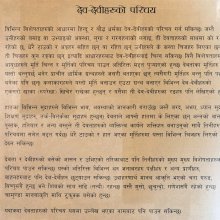Rahita, Rahitā: 21 definitions
Introduction:
Rahita means something in Buddhism, Pali, Hinduism, Sanskrit, Jainism, Prakrit, Marathi, Hindi. If you want to know the exact meaning, history, etymology or English translation of this term then check out the descriptions on this page. Add your comment or reference to a book if you want to contribute to this summary article.
Alternative spellings of this word include Rahit.
Images (photo gallery)
In Hinduism
Shaktism (Shakta philosophy)
Source: Google Books: ManthanabhairavatantramRahita (रहित) means “without” (i.e., devoid of), according to the Manthānabhairavatantra, a vast sprawling work that belongs to a corpus of Tantric texts concerned with the worship of the goddess Kubjikā.—Accordingly, “[...] I will now expound the sixfold introduction to the differentiated (sakala aspect). The Śāmbhava, supreme and tranquil, is above the six (Wheels). It is liberation, unique, tranquil, devoid of the Five Voids [i.e., khapañca-rahita] and beneficial. [...]”.
Source: ORA: Amanaska (king of all yogas): (shaktism)Rahita (रहित) refers to “one who does not practice (certain rituals or ceremonies)”, according to the 17th century Kaulagajamardana (“crushing the Kaula elephant”) authored by Kāśīnātha or Kṛṣṇānandācala.—Accordingly, [as Īśvara said to Pārvatī]: “[...] [Now,] my dear, hear about the Kāpālika. He eats from a skull bowl and is addicted to wine and flesh; he neglects the disciplines of purification and he is adorned with a bald head and Mālās; he eats from the fires of the cremation ground; he alone is a Kāpālika, he never does [the proper] repetition of Mantras, nor ascetic practices nor [follows] the rules of personal restraint. He is without (rahita) such [rituals] as bathing and ceremonies for donation [snānadānādirahitaḥ]. [Thus,] he is proclaimed a Pāṣānḍa. [...]”

Shakta (शाक्त, śākta) or Shaktism (śāktism) represents a tradition of Hinduism where the Goddess (Devi) is revered and worshipped. Shakta literature includes a range of scriptures, including various Agamas and Tantras, although its roots may be traced back to the Vedas.
Purana and Itihasa (epic history)
Source: archive.org: Shiva Purana - English TranslationRahita (रहित) means “without”, according to the Śivapurāṇa 2.3.13 (“Śiva-Pārvatī dialogue”).—Accordingly, as Śiva said to Pārvatī: “I am destroying the Prakṛti with my great penance. I remain in reality without Prakṛti [i.e., rahita—rahitaśśambhurahaṃ]. Indeed Prakṛti should not be taken in by good people. They should remain unaffected eschewing all worldly conduct”.

The Purana (पुराण, purāṇas) refers to Sanskrit literature preserving ancient India’s vast cultural history, including historical legends, religious ceremonies, various arts and sciences. The eighteen mahapuranas total over 400,000 shlokas (metrical couplets) and date to at least several centuries BCE.
Shaivism (Shaiva philosophy)
Source: Brill: Śaivism and the Tantric TraditionsRahita (रहित) (Cf. Hīna) refers to “without” (i.e., ‘being void of’), according to the 13th-century Matsyendrasaṃhitā: a Kubjikā-Tripurā oriented Tantric Yoga text of the Ṣaḍanvayaśāmbhava tradition from South India.—Accordingly, “[The Goddess spoke]:—Tell me, O Maheśvara, how should the Yogin sexually approach the one who is called Māyā, who has neither form/beauty (rūpa-rahitā) nor a clan/noble family/body (kūla-hīnā) ? [Bhairava spoke]:—Listen to me, O Goddess, I shall teach you the extraordinary intercourse with Māyā. It is fruitful, O Maheśānī, and difficult to learn by others and Yogins without yogic Powers, O Suranāyakī”.

Shaiva (शैव, śaiva) or Shaivism (śaivism) represents a tradition of Hinduism worshiping Shiva as the supreme being. Closely related to Shaktism, Shaiva literature includes a range of scriptures, including Tantras, while the root of this tradition may be traced back to the ancient Vedas.
Yoga (school of philosophy)
Source: ORA: Amanaska (king of all yogas): A Critical Edition and Annotated Translation by Jason BirchRahita (रहित) refers to “that which is devoid (of everything external)”, according to sources such as the Candrāvalokana and the Anubhavanivedanastotra.—Accordingly, while describing the highest reality through the practice of Śāmbhavī Mudrā: “[...] [The Yogin’s] eyes are half open, his mind steady and his gaze placed at the tip of the nose. Even his moon and sun have dissolved and his body is motionless. He goes to that supreme intensely radiant state, the highest reality, which has the appearance of light and is devoid of everything external (aśeṣabāhya-rahita). What could be spoken of here that is greater [than this]?”.

Yoga is originally considered a branch of Hindu philosophy (astika), but both ancient and modern Yoga combine the physical, mental and spiritual. Yoga teaches various physical techniques also known as āsanas (postures), used for various purposes (eg., meditation, contemplation, relaxation).
In Buddhism
Mahayana (major branch of Buddhism)
Source: Wisdom Library: Maha Prajnaparamita SastraRahita (रहित) refers to “devoid” (i.e., ‘one who is free’ of the fetters), according to Mahāprajñāpāramitāśāstra (chapter 19).—Accordingly, “Pure generosity is that which shows characteristics opposite to those just mentioned. Furthermore, pure generosity is the gift made in view of the Path (mārga); having arisen from a pure mind, (viṣuddhacitta-utpanna), free of the fetters (saṃyojana-rahita), not looking for happiness here below or up above (ihaparatrasukha), a gift made with respect (satkāra) and out of compassion (karuṇā). [...]”.

Mahayana (महायान, mahāyāna) is a major branch of Buddhism focusing on the path of a Bodhisattva (spiritual aspirants/ enlightened beings). Extant literature is vast and primarely composed in the Sanskrit language. There are many sūtras of which some of the earliest are the various Prajñāpāramitā sūtras.
Tibetan Buddhism (Vajrayana or tantric Buddhism)
Source: OSU Press: Cakrasamvara SamadhiRahita (रहित) refers to the “abandonment” (of hatred) [i.e., niḥśeṣa-dveṣa rahitasya mahāsukhasya], according to the Guru Mandala Worship (maṇḍalārcana) ritual often performed in combination with the Cakrasaṃvara Samādhi, which refers to the primary pūjā and sādhanā practice of Newah Mahāyāna-Vajrayāna Buddhists in Nepal.—Accordingly, “To reach the happiness, in the heart of all beings, Of the whole soul, of the highest dharma family ruler, Of the abandonment (rahita) of hatred entirely, of great bliss, That happiness, be to you, the farthest consecration”.

Tibetan Buddhism includes schools such as Nyingma, Kadampa, Kagyu and Gelug. Their primary canon of literature is divided in two broad categories: The Kangyur, which consists of Buddha’s words, and the Tengyur, which includes commentaries from various sources. Esotericism and tantra techniques (vajrayāna) are collected indepently.
In Jainism
General definition (in Jainism)
Source: The University of Sydney: A study of the Twelve ReflectionsRahita (रहित) refers to “devoid of”, according to the 11th century Jñānārṇava, a treatise on Jain Yoga in roughly 2200 Sanskrit verses composed by Śubhacandra.—Accordingly, “The three worlds, which are made foolish by the action of the poison of lust, are fast asleep in this gaping mouth of Yama’s serpent which is marked by fangs of destruction. While this one whose disposition is pitiless [com.—dayā-rahita-buddhi—‘one whose mind is devoid of pity’] is devouring everyone, certainly there is no way out from this for you, noble fellow, by any means [even] with some difficulty without knowledge of what is beyond the senses. [Thus ends the reflection on] helplessness”.
Synonyms: Śūnya, Vihīna.

Jainism is an Indian religion of Dharma whose doctrine revolves around harmlessness (ahimsa) towards every living being. The two major branches (Digambara and Svetambara) of Jainism stimulate self-control (or, shramana, ‘self-reliance’) and spiritual development through a path of peace for the soul to progess to the ultimate goal.
Languages of India and abroad
Pali-English dictionary
Source: BuddhaSasana: Concise Pali-English Dictionaryrahita : (adj.) deprived of; without.
Source: Sutta: The Pali Text Society's Pali-English DictionaryRahita, (pp. of rah) 1. lonely, forsaken Th. 2, 373 (gantum icchasi rahitaṃ bhiṃsanakaṃ mahāvanaṃ).—2. deprived of, without (-°) J. III, 369 (buddhiyā rahitā sattā); DA. I, 36 (avaṇṇa°); PvA. 63 (bhoga°), 67 (ācāra°), 77 (gandha°). Note. samantarahita is to be divided as sam-antarahita. (Page 567)

Pali is the language of the Tipiṭaka, which is the sacred canon of Theravāda Buddhism and contains much of the Buddha’s speech. Closeley related to Sanskrit, both languages are used interchangeably between religions.
Marathi-English dictionary
Source: DDSA: The Molesworth Marathi and English Dictionaryrahita (रहित).—a (S) Destitute or void of; unaccompanied with; standing or being without. Used in comp. without end; as jalarahita, dugdharahita, vidyā- rahita, dhanarahita, kāmarahita, krōdharahita.
--- OR ---
rahīta (रहीत).—a (rāhaṇēṃ) Remaining; lying over from the former account;--used esp. by Karkuns or accountants, and with such words as -aḍāvā-jamā- kharca-bērīja-rakama-tārīkha-mitī-vyāja-śilaka. 2 Left, remaining, lying; i. e. that is not now to be done, used, taken &c.
Source: DDSA: The Aryabhusan school dictionary, Marathi-Englishrahita (रहित).—a Void of; being without.
--- OR ---
rahīta (रहीत).—a Remaining, lying over the former account.
Marathi is an Indo-European language having over 70 million native speakers people in (predominantly) Maharashtra India. Marathi, like many other Indo-Aryan languages, evolved from early forms of Prakrit, which itself is a subset of Sanskrit, one of the most ancient languages of the world.
Sanskrit dictionary
Source: DDSA: The practical Sanskrit-English dictionaryRahita (रहित).—p. p. [rah-karmaṇi kta]
1) Quitted, left, abandoned, deserted.
2) Separated from, free from, deprived or destitute of, without (with instr. or at the end of comp.); रहिते भिक्षुभिर्ग्रामे (rahite bhikṣubhirgrāme) Y.3.59; गुणरहितः (guṇarahitaḥ); सत्त्वरहितः (sattvarahitaḥ) &c.
3) Lonely, solitary.
-tam Secrecy, privacy; नोपासितव्यौ रहिते कदाचित् (nopāsitavyau rahite kadācit) Mahābhārata (Bombay) 3.234.1.
Source: Cologne Digital Sanskrit Dictionaries: Shabda-Sagara Sanskrit-English DictionaryRahita (रहित).—mfn.
(-taḥ-tā-taṃ) 1. Left, quitted, abandoned. 2. Free from, devoid of. E. rah to leave, aff. kta .
Source: Cologne Digital Sanskrit Dictionaries: Cappeller Sanskrit-English DictionaryRahita (रहित).—[adjective] left, deserted, alone; destitute of, wanting ([instrumental], °— or —°).
Source: Cologne Digital Sanskrit Dictionaries: Monier-Williams Sanskrit-English Dictionary1) Rahita (रहित):—[from rah] mfn. left, quitted, forsaken, deserted, lonely, solitary, [Mahābhārata; Rāmāyaṇa] etc. (te ind. or teṣu ind. in secret, secretly, privately)
2) [v.s. ...] deserted by, separated or free from, deprived or void or destitute of ([instrumental case] or [compound]), [Yājñavalkya; Mahābhārata etc.]
3) [v.s. ...] ([in the beginning of a compound]) wanting, absent (cf. below).
Source: Cologne Digital Sanskrit Dictionaries: Yates Sanskrit-English DictionaryRahita (रहित):—[(taḥ-tā-taṃ) a.] Left, abandoned.
Source: DDSA: Paia-sadda-mahannavo; a comprehensive Prakrit Hindi dictionary (S)Rahita (रहित) in the Sanskrit language is related to the Prakrit word: Rahia.
Sanskrit, also spelled संस्कृतम् (saṃskṛtam), is an ancient language of India commonly seen as the grandmother of the Indo-European language family (even English!). Closely allied with Prakrit and Pali, Sanskrit is more exhaustive in both grammar and terms and has the most extensive collection of literature in the world, greatly surpassing its sister-languages Greek and Latin.
Hindi dictionary
Source: DDSA: A practical Hindi-English dictionaryRahita (रहित) [Also spelled rahit]:—(a) without, devoid of, bereft of.
...
Kannada-English dictionary
Source: Alar: Kannada-English corpusRahita (ರಹಿತ):—[adjective] lacking; not having.
--- OR ---
Rahita (ರಹಿತ):—
1) [noun] the act of leaving, abandoning.
2) [noun] a man who lacks, does not have (such and such a thing, character, etc.).
Kannada is a Dravidian language (as opposed to the Indo-European language family) mainly spoken in the southwestern region of India.
See also (Relevant definitions)
Starts with: Rahitagha, Rahitanukule, Rahitaratna, Rahitaratnacaya, Rahitasura, Rahitatman, Rahitatva.
Ends with (+103): Abhidheyarahita, Abhiprahita, Adhararahita, Adhivyadhirahita, Adimadhyantararahita, Adyamtarahita, Agamarahita, Agnirahita, Agrahita, Ahamrahita, Anandarahita, Anirahita, Anitirahita, Antarahita, Anugrahita, Anuprahita, Aprahita, Apratigrahita, Arahita, Arasagrahita.
Full-text (+73): Rahia, Lajjarahita, Uttararahita, Shraddharahita, Vyatharahita, Vyadhirahita, Sangarahita, Yuyutsarahita, Virahita, Svikararahita, Agamarahita, Rahitya, Rah, Arahita, Vipadrahita, Rahitasura, Vipattirahita, Abhidheyarahita, Catushkotika, Rahitaratnacaya.
Relevant text
Search found 33 books and stories containing Rahita, Rahitā, Rahīta; (plurals include: Rahitas, Rahitās, Rahītas). You can also click to the full overview containing English textual excerpts. Below are direct links for the most relevant articles:
Garga Samhita (English) (by Danavir Goswami)
Verse 1.9.15 < [Chapter 9 - Description of Vasudeva’s Wedding]
Verse 2.15.35 < [Chapter 15 - Description of Śrī Rādhā-Kṛṣṇa’s Falling in Love]
Verse 1.17.19 < [Chapter 17 - Description of the Yogurt Theft]
Sahitya-kaumudi by Baladeva Vidyabhushana (by Gaurapada Dāsa)
Text 1.3 < [Chapter 1 - The Purpose of Poetry]
Text 5.10 < [Chapter 5 - Second-rate Poetry]
Text 2.17 < [Chapter 2 - The Natures of Words (śabda)]
Hari-bhakti-kalpa-latikā (by Sarasvati Thkura)
Text 4 < [Second Stabaka]
Shrimad Bhagavad-gita (by Narayana Gosvami)
Verse 18.23 < [Chapter 18 - Mokṣa-yoga (the Yoga of Liberation)]
Verse 4.18 < [Chapter 4 - Jñāna-Yoga (Yoga through Transcendental Knowledge)]
Bhakti-rasamrta-sindhu (by Śrīla Rūpa Gosvāmī)
Verse 2.1.246 < [Part 1 - Ecstatic Excitants (vibhāva)]
Verse 2.1.245 < [Part 1 - Ecstatic Excitants (vibhāva)]

